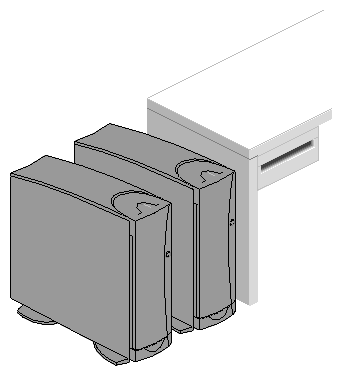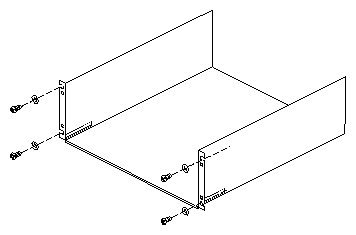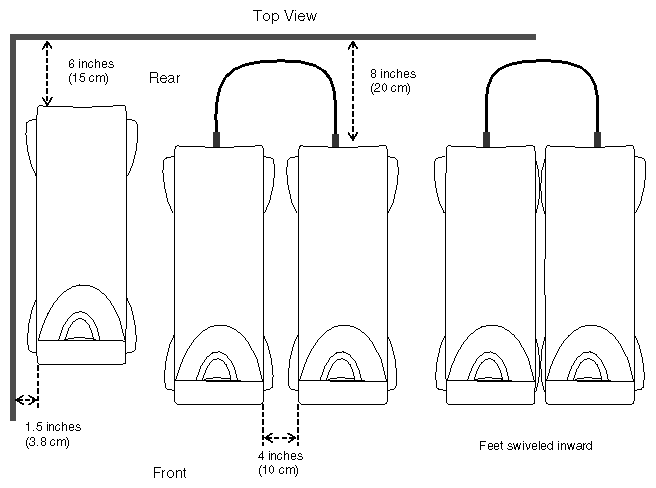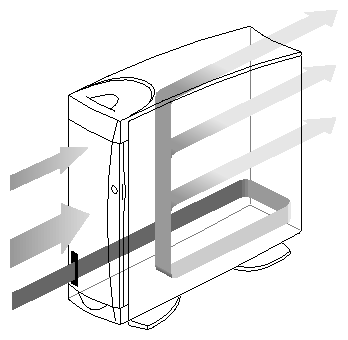The Origin200 and Origin Vault chassis provide a very high-performance computer system or peripherals expansion chassis in a compact tower-style or rack-mountable package.
A brief overview of these systems follows. While these descriptions are current as of the date of publication, please refer to the most recent SGI price book for the latest information.
Origin200—A floor-standing or rack-mountable server offering from one to four processors in one or two chassis (one or two processors per chassis).
Origin Vault—A floor-standing or rack-mountable SCSI peripherals module that may be used with O2, Octane, Origin200, Origin2000, or Onyx2 systems. It is included in this chapter due to its strong similarity to the Origin200 server chassis.

Note: For site preparation information about Origin 200 systems or Origin Vault modules mounted in an SGI Peripherals rack, see Chapter 8, “Site Preparation for SGI 2000-series, Origin Peripherals, and Onyx2 Rack Chassis”.
SGI Origin200 and Origin Vault systems are designed to be located either upright (for example, beside a desk) or mounted in a 19-inch rack. The deskside configuration of the Origin200 and Origin Vault is sometimes called a tower configuration. Figure 5-1 and Figure 5-2 show the Origin200 or Origin Vault system in its deskside and rack-mountable configurations, respectively.
Origin200 and Origin Vault systems are shipped with feet, as shown in Figure 5-1. For use in a rack, the feet and skins are removed, as shown in Figure 5-2. To avoid tipping over the system, it is recommended that these feet be installed for any configuration in which the system is placed vertically.
Figure 5-4 shows the required clearances for the Origin200 and Origin Vault chassis, both singly and in pairs. Clearance requirements on single chassis installations are for airflow.
Origin200 systems are designed to be connected with CrayLink cables, and an Origin200 system often has a companion Origin Vault chassis, which is connected with a SCSI cable. Clearance requirements for multiple chassis are thus based both on cabling and airflow issues.
Figure 5-5 shows the airflow path in Origin200 and Origin Vault chassis. Be sure that the location selected allows free flow of air to and from the areas shown.
For an illustration of airflow in Origin200 or Origin Vault systems mounted in a rack chassis, see Figure 8-7.
Origin200 systems are designed for use in typical office computing environments. The air temperature should not fluctuate dramatically, air should circulate freely, and the location should be relatively dust free.
Specific information about power requirements is provided in “Origin200 Power and Cooling Requirements” and “Origin Vault Power and Cooling Requirements”.
Besides providing enough power for the systems, in the case of multiple Origin200 systems joined with CrayLink cables, there is an additional requirement: the ground potentials must be unusually close.
| Warning: Any difference in ground potential greater than 500 millivolts (0.5 volts) between two chassis connected with CrayLink or XTown cables can cause severe equipment damage. For further information, see “Chassis Branch Circuit Grounding” in Appendix B. |
For information about selecting a physical location for an Origin200 system, see “Selecting a Location for an Origin200 or Origin Vault System”.
Table 5-1 lists the physical specifications of the Origin200 chassis.
Table 5-1. Origin200 Chassis Physical Specifications
Dimensions |
|
|
With skins: | length | 26” (66 cm) |
Without skins: | length | 24.3” (61.7 cm) |
Shipping: | length | 31.5” (80 cm) |
Weight: | minimum | 59 lbs (26.8 kg) |
Air Temperature |
|
|
Operating: | 0-5,000 ft | 41° to 95° F (5° to 35° C) |
Non-Operating: |
| -4° to 140° F (-20° to 60° C) |
Thermal Gradient: | maximum | 18° F (10° C) per hour |
Altitude: | operating | 10,000 ft (3,048 m) MSL, maximum |
Relative Humidity: | operating | 10-90% (non-condensing) |
Humidity Gradient: | maximum | 10% relative humidity per hour |
Acoustics: | typical | 50 dBa |
Vibration: | maximum, sustained | 0.01”, 5-10 Hz; 0.1 G 10-500 Hz (operating) |
Table 5-2 provides power consumption and required cooling capacity information for the Origin200 system. For formulas, descriptions, and general information about power and cooling, refer to “ Electrical Requirements” in Chapter 2 and “ Thermal Requirements” in Chapter 2.
| Caution: Origin200 systems are highly configurable, and different configurations can have a wide range of power and cooling requirements. It is uncommon for an Origin200 system to reach the “maximum” power and cooling requirements listed in Table 5-2. Ask your SGI representative about particular configurations. |
Table 5-2. Origin200 Power and Cooling Specifications
Volts: |
| 100-120 volts AC, 1-phase |
Watts (from-the-wall): | typical | 350 watts |
Power Factor: | minimum | 0.98 |
Total Harmonic Dist.: | at 120 volts | 5% maximum |
Inrush Current: | peak | 140 amps |
Frequency: |
| 47-63 Hz |
Cooling Requirements: | typical | 1,194 Btu/hr (0.10-ton AC load) |
Airflow Volume: | maximum | 100 cfm (0.047 m3/s) |
See Appendix B, “Site Power and Power Cables”, for information about Origin200 chassis site-wiring and power cables.
Origin200 systems usually use a standard serial ASCII terminal as a console. See “ASCII Terminals” in Appendix A for more information.
An Origin200 system may also have one or more external SCSI devices attached to it. For small SCSI devices, see “External SCSI Devices” in Appendix A. Also see information on Origin Vault systems in “Origin Vault Site Requirements”.
Besides power cables and external SCSI peripherals (mentioned above), Origin200 systems are typically wired to network cables, serial and parallel devices, and so on. For details of the ports found on an Origin200 system, see the Origin200 Owner's Guide.
An Origin200 system may also be connected to another Origin200 system with a CrayLink cable (as shown in Figure 5-4).
| Warning: Any difference in ground potential greater than 500 millivolts (0.5 volts) between two chassis connected with CrayLink or XTown cables can cause severe equipment damage. For further information, see “Chassis Branch Circuit Grounding” in Appendix B. |
For information about selecting a physical location for an Origin Vault system, see “Selecting a Location for an Origin200 or Origin Vault System”.
Table 5-3 lists the physical specifications of the Origin Vault chassis.
Table 5-3. Origin Vault Physical Specifications
Dimensions |
|
|
With skins: | length | 26” (66 cm) |
Without skins: | length | 24.3” (61.7 cm) |
Shipping: | length | 31.5” (80 cm) |
Weight: | minimum | 30 lbs (13.6 kg) |
Air Temperature |
|
|
Operating: | 0-5,000 ft | 41° to 95° F (5° to 35° C) |
Non-Operating: |
| -4° to 140° F (-20° to 60° C) |
Thermal Gradient: | maximum | 18° F (10° C) per hour |
Altitude: | operating | 10,000 ft (3,048 m) MSL, maximum |
Relative Humidity: | operating | 10-90% (non-condensing) |
Humidity Gradient: | maximum | 10% relative humidity per hour |
Acoustics: | typical | 50 dBa |
Vibration: | maximum, sustained | 0.01”, 5-10 Hz; 0.1 G 10-500 Hz (operating) |
Table 5-4 provides power consumption and required cooling capacity information for the Origin Vault chassis. For formulas, descriptions, and general information about power and cooling, refer to “ Electrical Requirements” in Chapter 2 and “ Thermal Requirements” in Chapter 2.
| Caution: The power and cooling requirements for an Origin Vault chassis vary significantly based on the quantity and type of peripheral devices installed in that chassis. It is rare for an Origin Vault chassis to reach the “maximum” power and cooling requirements listed in Table 5-4. Ask your SGI representative about particular configurations. |
Table 5-4. Origin Vault Power and Cooling Specifications
Volts: |
| 100-120 volts AC, 1-phase |
Watts (from-the-wall): | typical | 100 watts |
Power Factor: | minimum | 0.98 |
Total Harmonic Dist.: | at 120 volts | 5% maximum |
Inrush Current: | peak | 140 amps |
Frequency: |
| 47-63 Hz |
Cooling Requirements: | typical | 341 Btu/hr (0.03-ton AC load) |
Airflow Volume: | maximum | 100 cfm (0.047 m3/s) |
See Appendix B, “Site Power and Power Cables”, for information about Origin200 chassis site-wiring and power cables.
The Origin Vault chassis is available with either a single-ended or differential SCSI interface. Single-ended SCSI has a maximum bus-length of 3 meters. Differential SCSI has a maximum bus-length of 25 meters. These lengths, however, include all portions of the SCSI cable, both inside and outside the chassis. Where possible, it is best to keep SCSI buses well below these rated maximum lengths.
The cables will probably not run in a straight line from the host system's SCSI port to the Origin Vault chassis. Instead, they may run under a floor, or around systems. In this way, systems with a straight-line distance that is well within the limitations of the SCSI bus may, in fact, be too far apart.
Consider all of these factors when choosing a site for an Origin Vault chassis.




